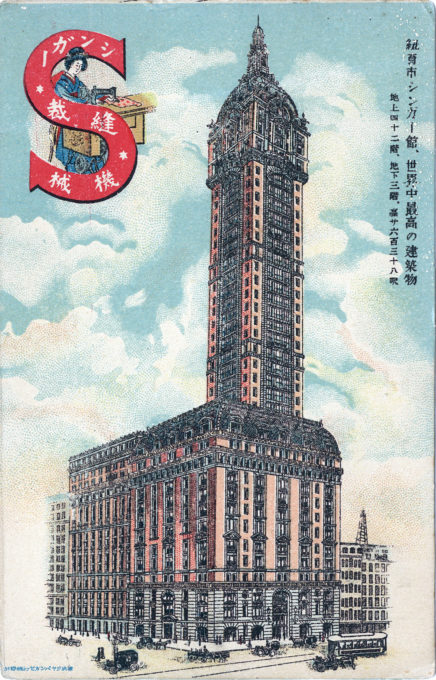
Singer Sewing Machine Co. headquarters, New York City., c. 1920. Japanese advertising postcard for シンガー 裁 縫 機 裁 [Shi-n-gaa Housai Ki Kai, “Singer Stitching Loom Machine”].
See also:
Kodak Verichrome Film & “Vest Pocket” Camera, Japan, c. 1932.
Maiko with “Nipponophone”, c. 1910.
“When the Singer Sewing Machine Company entered the Japanese market in earnest in 1900, it brought a half-century of experience as ‘the world’s most successful multinational company.’
“Founded in 1851 by Isaac Merritt Singer, the company focused on world markets and household users from the outset. By 1864, exports accounted for 40 percent of the machines it sold … By the eve of World War I, shipping its product from factories in the United States (New Jersey), Scotland, and Russia, Singer controlled 60 percent of the American market in household machines and probably 90 percent of foreign markets … The Singer magic lay in ‘its direct selling organizations knocking on people’s doors all around the world.’
“… Singer was founded and headquartered in the United States, where its forty-one story building in lower Manhattan was the tallest in the world when it opened in 1908. Developed in America, the renowned selling system which it brought to Japan in 1900 had by then taken firm shape as a product of trans-Atlantic and transnational experience. The company drew on selling experience gained in Britain to devise its famous canvassing system … Against this background, it is no surprise that in early twentieth century Japan Singer proudly advertised the sewing machine as a good vanguard of global civilization, embraced by ‘Europeans and Americans … of all classes high and low.’
“… As Singer set up its operation in Japan, it made remarkably little adjustment to its selling system. In less than decade, Singer’s shops had spread throughout the country, and Singer used its standard global model in Japan with fair success until the early 1930s. Annual sales of its household machines reached twenty thousand in 1911, and roughly fifty thousand per year by the early 1920s.
“By the 1910s, Singer stood unchallenged with more than 80 percent of the Japanese household market … Singer’s management was quite localized; no more than a dozen American, Canadian, or European men worked as expatriate executives at any one time. Measured in employees, Singer was the largest foreign corporate presence in Japan.”
– Fabricating Consumers: The Sewing Machine in Modern Japan, by Andrew Gordon, 2012

